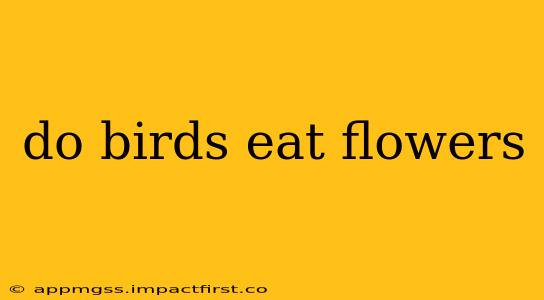Do Birds Eat Flowers? A Surprisingly Complex Question
The simple answer is: yes, some birds eat flowers. However, the specifics are far more nuanced than a simple yes or no. While birds primarily consume insects, seeds, fruits, and nectar, certain species incorporate flower parts into their diets, depending on availability, nutritional needs, and individual preferences. Let's delve deeper into the fascinating world of avian floral consumption.
What parts of flowers do birds eat?
Birds may consume various parts of a flower, including:
- Nectar: This sweet liquid is a primary food source for many hummingbirds, sunbirds, and honeyeaters. They have specialized beaks and tongues adapted for efficient nectar extraction.
- Petals: Certain birds, especially those with a more generalized diet, may consume petals for their moisture content or as a supplementary source of nutrients. This is less common than nectar consumption.
- Pollen: While not a primary food source for most birds, pollen can be incidentally ingested while foraging for nectar or insects. It does contain protein, so it's a nutritional bonus.
- Reproductive structures: In some cases, birds might consume the stamens (male reproductive parts) or pistils (female reproductive parts) of flowers, although this is less frequent. This behavior is often incidental rather than a targeted feeding strategy.
- Buds: Flower buds can be a source of food for some birds, offering a combination of nutrients and moisture.
Which birds eat flowers?
While many bird species occasionally consume flower parts, some are more reliant on floral resources than others:
- Hummingbirds: These tiny avian marvels are perhaps the most well-known flower eaters, relying heavily on nectar for energy. Their long, slender beaks are perfectly adapted for reaching deep into flowers.
- Sunbirds: Similar to hummingbirds, sunbirds are nectarivores found primarily in the Old World tropics. They play a crucial role in pollination.
- Honeyeaters: A diverse family of birds found in Australia, New Zealand, and surrounding islands, honeyeaters are specialized nectar feeders with brush-tipped tongues.
- Lorikeets: These brightly colored parrots are also known for their nectar-rich diets, often visiting flowers in large numbers.
Do birds eating flowers help or harm the plant?
The relationship between birds and flowers is often mutually beneficial. While some birds may damage flowers by consuming petals or other parts, many act as pollinators. As they feed on nectar, pollen sticks to their feathers and beaks, transferring it between flowers and enabling plant reproduction. This is a classic example of symbiotic co-evolution.
What are the benefits of birds eating flowers?
For birds, consuming flowers provides essential nutrients, particularly carbohydrates from nectar, and potentially some protein from pollen. For plants, the primary benefit is pollination, enabling them to reproduce and spread their genes.
Are there any downsides to birds eating flowers?
In some cases, overconsumption of flower parts by birds can negatively affect plant reproduction if vital reproductive structures are damaged. However, this is usually not a significant problem unless bird populations are exceptionally high in a particular area.
In conclusion, the answer to "Do birds eat flowers?" is a qualified yes. While not all birds regularly consume flowers, many species incorporate flower parts, primarily nectar, into their diet, playing a vital role in the ecosystem through pollination. The relationship is a complex interplay of mutualism and occasional conflict, demonstrating the intricate connections within the natural world.
